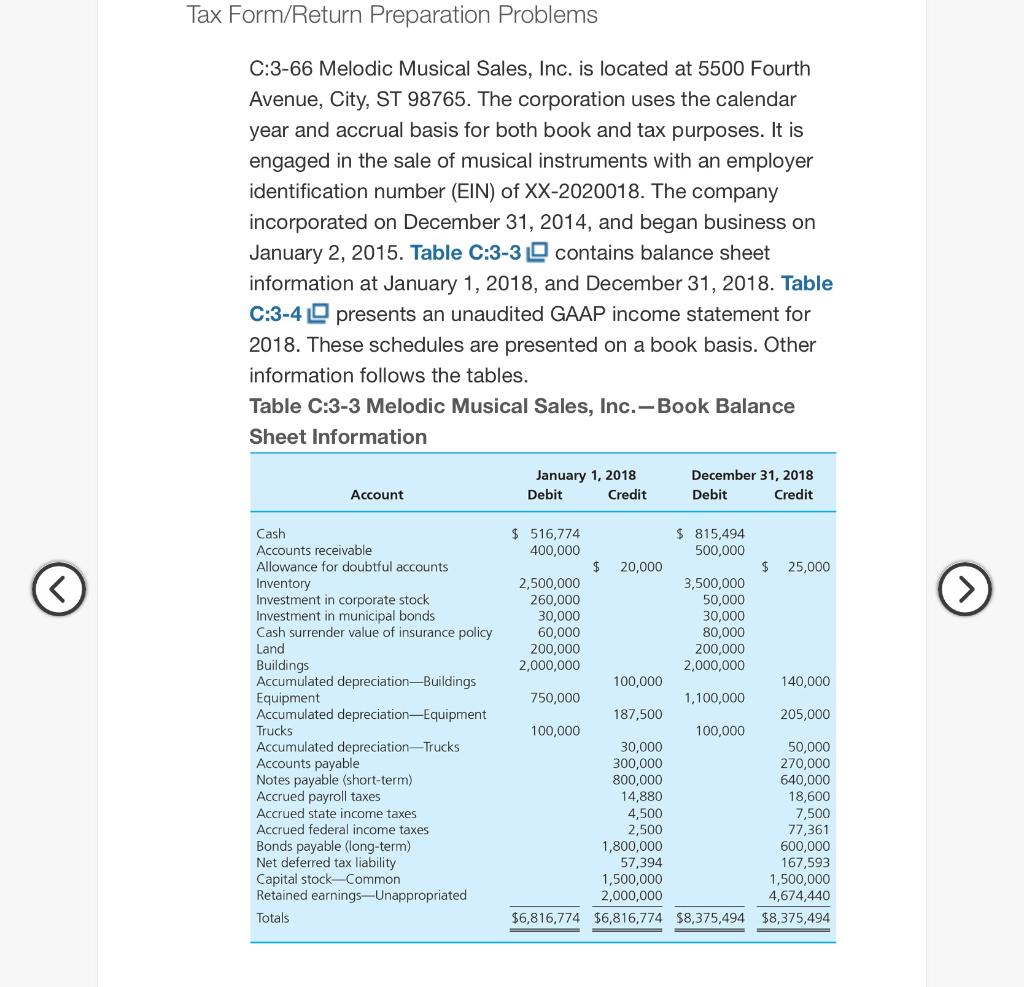
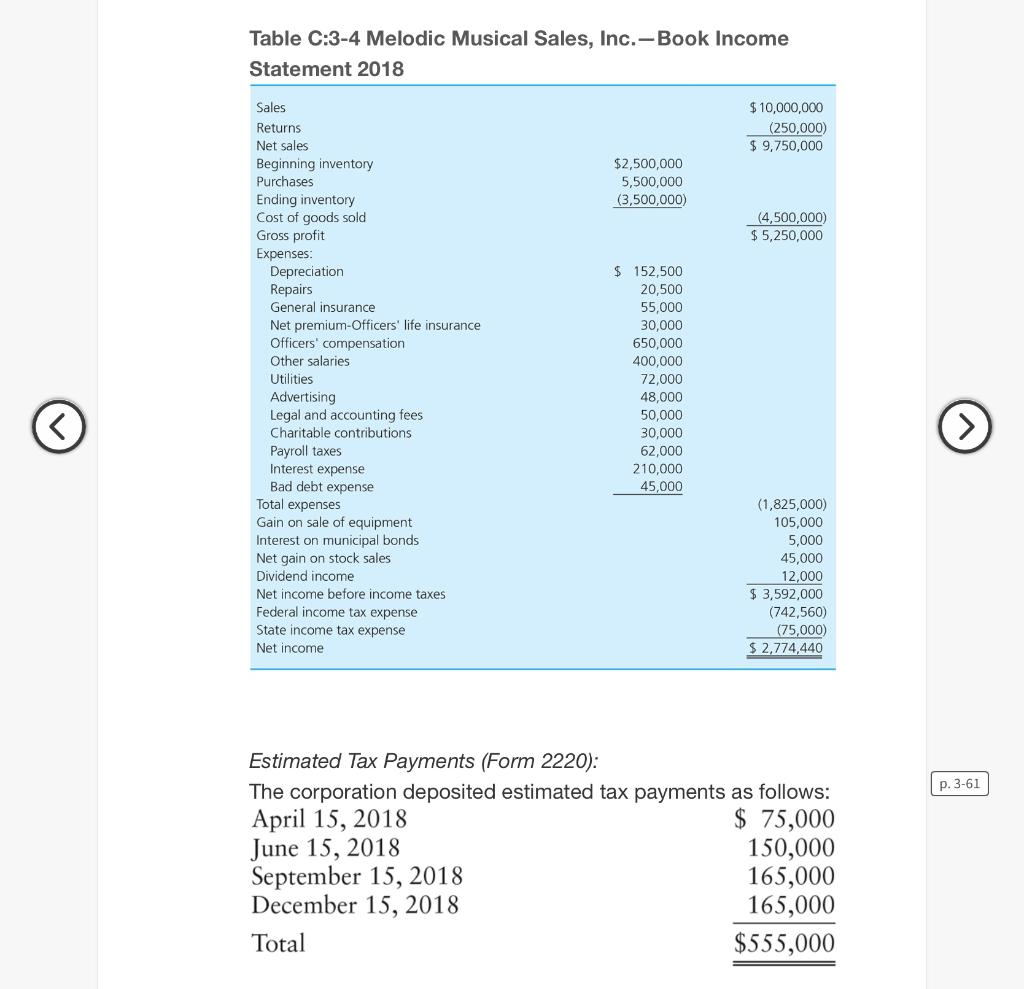
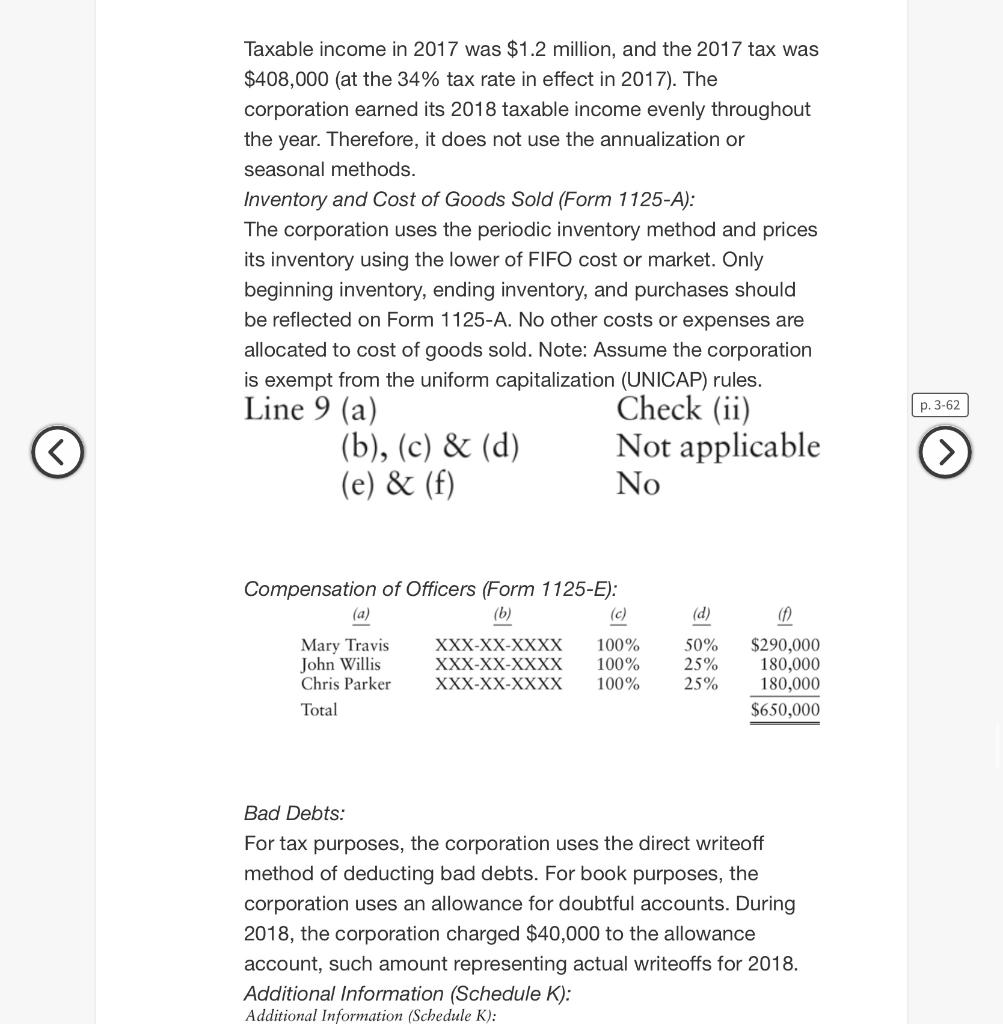
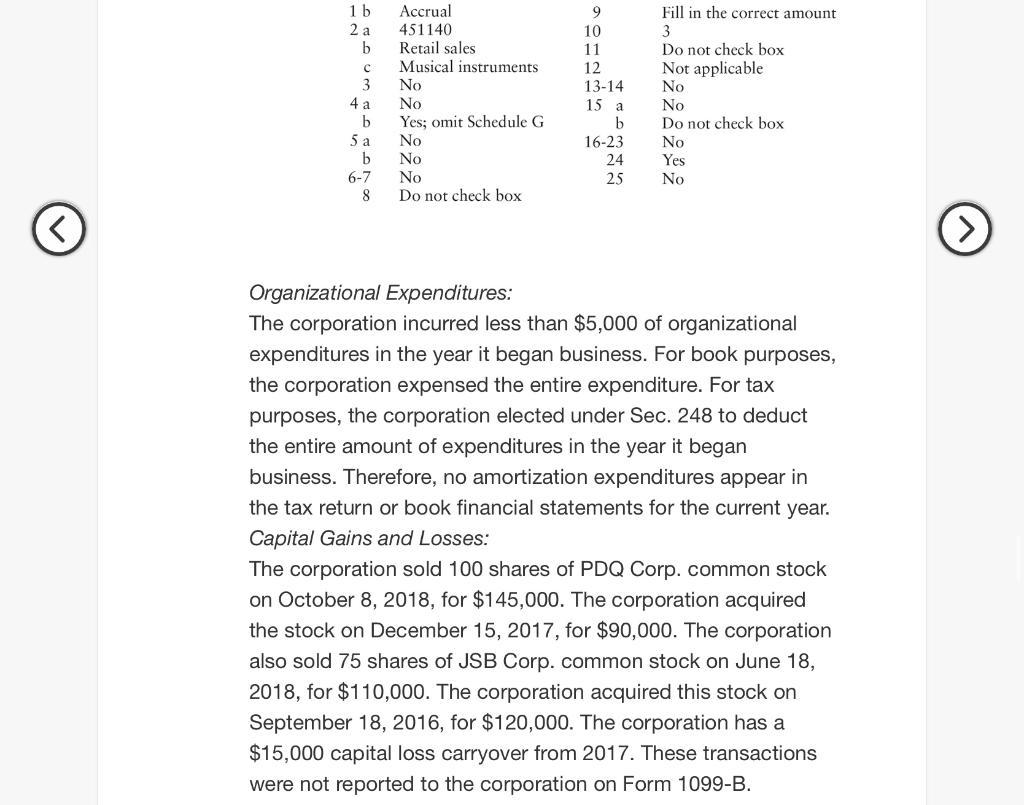

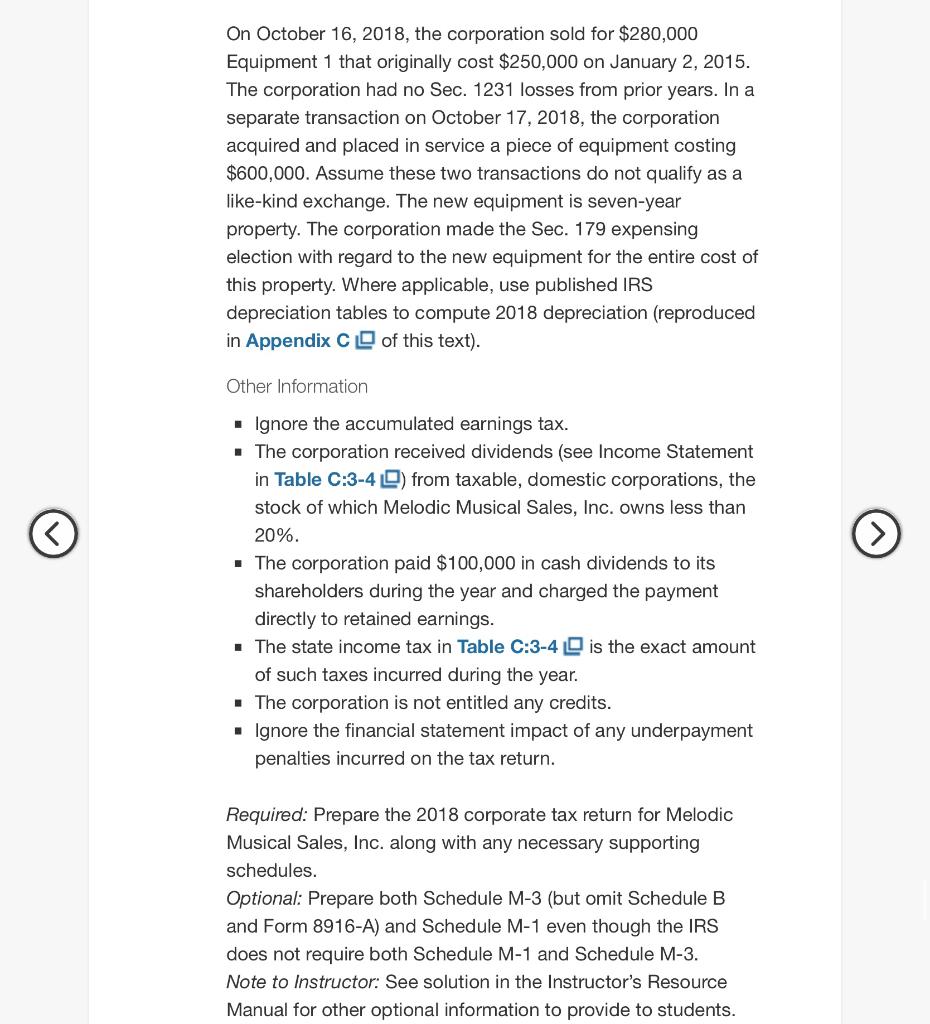
Tax Form/Return Preparation Problems C:3-66 Melodic Musical Sales, Inc. is located at 5500 Fourth Avenue, City, ST 98765. The corporation uses the calendar year and accrual basis for both book and tax purposes. It is engaged in the sale of musical instruments with an employer identification number (EIN) of XX-2020018. The company incorporated on December 31, 2014, and began business on January 2, 2015. Table C:3-3 contains balance sheet information at January 1, 2018, and December 31, 2018. Table C:3-4 presents an unaudited GAAP income statement for 2018. These schedules are presented on a book basis. Other information follows the tables. Table C:3-3 Melodic Musical Sales, Inc.-Book Balance Sheet Information January 1, 2018 Debit Credit December 31, 2018 Debit Credit Account $ 516,774 400,000 $ 815,494 500,000 $ 20,000 $ 25,000 > 2,500,000 260,000 30,000 60,000 200,000 2,000,000 3,500,000 50,000 30,000 80,000 200,000 2,000,000 Buildings 100,000 140,000 750,000 1,100,000 187,500 205,000 Cash Accounts receivable Allowance for doubtful accounts Inventory Investment in corporate stock Investment in municipal bonds Cash surrender value of insurance policy Land bo Accumulated depreciation Buildings Equipment Accumulated depreciation Equipment Trucks Accumulated depreciation-Trucks Accounts payable Notes payable (short-term) Accrued payroll taxes Accrued state income taxes Accrued federal income taxes Bonds payable (long-term) Net deferred tax liability Capital stock-Common Retained earnings--Unappropriated Totals 100,000 100,000 30,000 300,000 800,000 14,880 50,000 270,000 640,000 18,600 4,500 2,500 7,500 77,361 1,800,000 600,000 57,394 167,593 1,500,000 1,500,000 2,000,000 4,674,440 $6,816,774 $6,816,774 $8,375,494 $8,375,494 Table C:3-4 Melodic Musical Sales, Inc.-Book Income Statement 2018 $10,000,000 (250,000) $ 9,750,000 $2,500,000 5,500,000 (3,500,000) (4,500,000) $5,250,000 Sales Returns Net sales Beginning inventory Purchases Ending inventory Cost of goods sold Gross profit Expenses Depreciation Repairs General insurance Net premium-Officers' life insurance Officers' compensation Other salaries Utilities Advertising Legal and accounting fees Charitable contributions Payroll taxes Interest expense Bad debt expense Total expenses Gain on sale of equipment Interest on municipal bonds Net gain on stock sales Dividend income Net income before income taxes Federal income tax expense State income tax expense Net income $ 152,500 20,500 55,000 30,000 650,000 400,000 72,000 48,000 50,000 30,000 62,000 210,000 45,000 > (1,825,000) 105,000 5,000 45,000 12,000 $ 3,592,000 (742,560) (75,000) $ 2,774,440 p. 3-61 Estimated Tax Payments (Form 2220): The corporation deposited estimated tax payments as follows: April 15, 2018 $ 75,000 June 15, 2018 150,000 September 15, 2018 165,000 December 15, 2018 165,000 Total $555,000 Taxable income in 2017 was $1.2 million, and the 2017 tax was $408,000 (at the 34% tax rate in effect in 2017). The corporation earned its 2018 taxable income evenly throughout the year. Therefore, it does not use the annualization or seasonal methods. Inventory and Cost of Goods Sold (Form 1125-A): The corporation uses the periodic inventory method and prices its inventory using the lower of FIFO cost or market. Only beginning inventory, ending inventory, and purchases should be reflected on Form 1125-A. No other costs or expenses are allocated to cost of goods sold. Note: Assume the corporation is exempt from the uniform capitalization (UNICAP) rules. Line 9 (a) Check (ii) (b), (c) & (d) Not applicable (e) & (f) No p. 3-62 (d) Compensation of Officers (Form 1125-E): (6) (c) Mary Travis XXX-XX-XXXX 100% John Willis XXX-XX-XXXX 100% Chris Parker XXX-XX-XXXX 100% Total 50% 25% 25% $290,000 180,000 180,000 $650,000 Bad Debts: For tax purposes, the corporation uses the direct writeoff method of deducting bad debts. For book purposes, the corporation uses an allowance for doubtful accounts. During 2018, the corporation charged $40,000 to the allowance account, such amount representing actual writeoffs for 2018. Additional Information (Schedule K): Additional Information (Schedule K): 1 b 2 a b C 3 4 a b 5 a b 6-7 8 Accrual 451140 Retail sales Musical instruments No No Yes; omit Schedule G No No No Do not check box 9 10 11 12 13-14 15 a b 16-23 24 25 Fill in the correct amount 3 Do not check box Not applicable No No Do not check box No Yes No Organizational Expenditures: The corporation incurred less than $5,000 of organizational expenditures in the year it began business. For book purposes, the corporation expensed the entire expenditure. For tax purposes, the corporation elected under Sec. 248 to deduct the entire amount of expenditures in the year it began business. Therefore, no amortization expenditures appear in the tax return or book financial statements for the current year. Capital Gains and Losses: The corporation sold 100 shares of PDQ Corp. common stock on October 8, 2018, for $145,000. The corporation acquired the stock on December 15, 2017, for $90,000. The corporation also sold 75 shares of JSB Corp. common stock on June 18, 2018, for $110,000. The corporation acquired this stock on September 18, 2016, for $120,000. The corporation has a $15,000 capital loss carryover from 2017. These transactions were not reported to the corporation on Form 1099-B. Fixed Assets and Depreciation For book purposes: The corporation uses straight-line depreciation over the useful lives of assets as follows: store building, 50 years; equipment, ten years; and trucks, five years. The corporation takes a half-year's depreciation in the year of acquisition and the year of disposition and assumes no salvage value. The book financial statements in Tables C:3-3 and C:3-4 reflect these calculations. For tax purposes: All assets are MACRS property as follows: store building, 39-year nonresidential real property; equipment, seven-year property; and trucks, five-year property. The corporation acquired the store building for $2 million and placed it in service on January 2, 2015. The corporation acquired two pieces of equipment for $250,000 (Equipment 1) and $500,000 (Equipment 2) and placed them in service on January 2, 2015. The corporation acquired the trucks for $100,000 and placed them in service on July 18, 2016. The trucks are not listed property and are not subject to the limitation on luxury automobiles. The corporation did not make the expensing election under Sec. 179 or take bonus depreciation on any property acquired before 2018. Accumulated tax depreciation through December 31, 2017, on these properties is as follows: p. 3-63 Store building Equipment 1 Equipment 2 Trucks $ 151,780 140,675 281,350 52,000 On October 16, 2018, the corporation sold for $280,000 Equipment 1 that originally cost $250,000 on January 2, 2015. The corporation had no Sec. 1231 losses from prior years. In a separate transaction on October 17, 2018, the corporation acquired and placed in service a piece of equipment costing $600,000. Assume these two transactions do not qualify as a like-kind exchange. The new equipment is seven-year property. The corporation made the Sec. 179 expensing election with regard to the new equipment for the entire cost of this property. Where applicable, use published IRS depreciation tables to compute 2018 depreciation (reproduced in Appendix CO of this text). Other Information Ignore the accumulated earnings tax. The corporation received dividends (see Income Statement in Table C:3-4) from taxable, domestic corporations, the stock of which Melodic Musical Sales, Inc. owns less than 20%. The corporation paid $100,000 in cash dividends to its shareholders during the year and charged the payment directly to retained earnings. The state income tax in Table C:3-4 is the exact amount of such taxes incurred during the year. The corporation is not entitled any credits. Ignore the financial statement impact of any underpayment penalties incurred on the tax return. Required: Prepare the 2018 corporate tax return for Melodic Musical Sales, Inc. along with any necessary supporting schedules. Optional: Prepare both Schedule M-3 (but omit Schedule B and Form 8916-A) and Schedule M-1 even though the IRS does not require both Schedule M-1 and Schedule M-3. Note to Instructor: See solution in the Instructor's Resource Manual for other optional information to provide to students. Tax Form/Return Preparation Problems C:3-66 Melodic Musical Sales, Inc. is located at 5500 Fourth Avenue, City, ST 98765. The corporation uses the calendar year and accrual basis for both book and tax purposes. It is engaged in the sale of musical instruments with an employer identification number (EIN) of XX-2020018. The company incorporated on December 31, 2014, and began business on January 2, 2015. Table C:3-3 contains balance sheet information at January 1, 2018, and December 31, 2018. Table C:3-4 presents an unaudited GAAP income statement for 2018. These schedules are presented on a book basis. Other information follows the tables. Table C:3-3 Melodic Musical Sales, Inc.-Book Balance Sheet Information January 1, 2018 Debit Credit December 31, 2018 Debit Credit Account $ 516,774 400,000 $ 815,494 500,000 $ 20,000 $ 25,000 > 2,500,000 260,000 30,000 60,000 200,000 2,000,000 3,500,000 50,000 30,000 80,000 200,000 2,000,000 Buildings 100,000 140,000 750,000 1,100,000 187,500 205,000 Cash Accounts receivable Allowance for doubtful accounts Inventory Investment in corporate stock Investment in municipal bonds Cash surrender value of insurance policy Land bo Accumulated depreciation Buildings Equipment Accumulated depreciation Equipment Trucks Accumulated depreciation-Trucks Accounts payable Notes payable (short-term) Accrued payroll taxes Accrued state income taxes Accrued federal income taxes Bonds payable (long-term) Net deferred tax liability Capital stock-Common Retained earnings--Unappropriated Totals 100,000 100,000 30,000 300,000 800,000 14,880 50,000 270,000 640,000 18,600 4,500 2,500 7,500 77,361 1,800,000 600,000 57,394 167,593 1,500,000 1,500,000 2,000,000 4,674,440 $6,816,774 $6,816,774 $8,375,494 $8,375,494 Table C:3-4 Melodic Musical Sales, Inc.-Book Income Statement 2018 $10,000,000 (250,000) $ 9,750,000 $2,500,000 5,500,000 (3,500,000) (4,500,000) $5,250,000 Sales Returns Net sales Beginning inventory Purchases Ending inventory Cost of goods sold Gross profit Expenses Depreciation Repairs General insurance Net premium-Officers' life insurance Officers' compensation Other salaries Utilities Advertising Legal and accounting fees Charitable contributions Payroll taxes Interest expense Bad debt expense Total expenses Gain on sale of equipment Interest on municipal bonds Net gain on stock sales Dividend income Net income before income taxes Federal income tax expense State income tax expense Net income $ 152,500 20,500 55,000 30,000 650,000 400,000 72,000 48,000 50,000 30,000 62,000 210,000 45,000 > (1,825,000) 105,000 5,000 45,000 12,000 $ 3,592,000 (742,560) (75,000) $ 2,774,440 p. 3-61 Estimated Tax Payments (Form 2220): The corporation deposited estimated tax payments as follows: April 15, 2018 $ 75,000 June 15, 2018 150,000 September 15, 2018 165,000 December 15, 2018 165,000 Total $555,000 Taxable income in 2017 was $1.2 million, and the 2017 tax was $408,000 (at the 34% tax rate in effect in 2017). The corporation earned its 2018 taxable income evenly throughout the year. Therefore, it does not use the annualization or seasonal methods. Inventory and Cost of Goods Sold (Form 1125-A): The corporation uses the periodic inventory method and prices its inventory using the lower of FIFO cost or market. Only beginning inventory, ending inventory, and purchases should be reflected on Form 1125-A. No other costs or expenses are allocated to cost of goods sold. Note: Assume the corporation is exempt from the uniform capitalization (UNICAP) rules. Line 9 (a) Check (ii) (b), (c) & (d) Not applicable (e) & (f) No p. 3-62 (d) Compensation of Officers (Form 1125-E): (6) (c) Mary Travis XXX-XX-XXXX 100% John Willis XXX-XX-XXXX 100% Chris Parker XXX-XX-XXXX 100% Total 50% 25% 25% $290,000 180,000 180,000 $650,000 Bad Debts: For tax purposes, the corporation uses the direct writeoff method of deducting bad debts. For book purposes, the corporation uses an allowance for doubtful accounts. During 2018, the corporation charged $40,000 to the allowance account, such amount representing actual writeoffs for 2018. Additional Information (Schedule K): Additional Information (Schedule K): 1 b 2 a b C 3 4 a b 5 a b 6-7 8 Accrual 451140 Retail sales Musical instruments No No Yes; omit Schedule G No No No Do not check box 9 10 11 12 13-14 15 a b 16-23 24 25 Fill in the correct amount 3 Do not check box Not applicable No No Do not check box No Yes No Organizational Expenditures: The corporation incurred less than $5,000 of organizational expenditures in the year it began business. For book purposes, the corporation expensed the entire expenditure. For tax purposes, the corporation elected under Sec. 248 to deduct the entire amount of expenditures in the year it began business. Therefore, no amortization expenditures appear in the tax return or book financial statements for the current year. Capital Gains and Losses: The corporation sold 100 shares of PDQ Corp. common stock on October 8, 2018, for $145,000. The corporation acquired the stock on December 15, 2017, for $90,000. The corporation also sold 75 shares of JSB Corp. common stock on June 18, 2018, for $110,000. The corporation acquired this stock on September 18, 2016, for $120,000. The corporation has a $15,000 capital loss carryover from 2017. These transactions were not reported to the corporation on Form 1099-B. Fixed Assets and Depreciation For book purposes: The corporation uses straight-line depreciation over the useful lives of assets as follows: store building, 50 years; equipment, ten years; and trucks, five years. The corporation takes a half-year's depreciation in the year of acquisition and the year of disposition and assumes no salvage value. The book financial statements in Tables C:3-3 and C:3-4 reflect these calculations. For tax purposes: All assets are MACRS property as follows: store building, 39-year nonresidential real property; equipment, seven-year property; and trucks, five-year property. The corporation acquired the store building for $2 million and placed it in service on January 2, 2015. The corporation acquired two pieces of equipment for $250,000 (Equipment 1) and $500,000 (Equipment 2) and placed them in service on January 2, 2015. The corporation acquired the trucks for $100,000 and placed them in service on July 18, 2016. The trucks are not listed property and are not subject to the limitation on luxury automobiles. The corporation did not make the expensing election under Sec. 179 or take bonus depreciation on any property acquired before 2018. Accumulated tax depreciation through December 31, 2017, on these properties is as follows: p. 3-63 Store building Equipment 1 Equipment 2 Trucks $ 151,780 140,675 281,350 52,000 On October 16, 2018, the corporation sold for $280,000 Equipment 1 that originally cost $250,000 on January 2, 2015. The corporation had no Sec. 1231 losses from prior years. In a separate transaction on October 17, 2018, the corporation acquired and placed in service a piece of equipment costing $600,000. Assume these two transactions do not qualify as a like-kind exchange. The new equipment is seven-year property. The corporation made the Sec. 179 expensing election with regard to the new equipment for the entire cost of this property. Where applicable, use published IRS depreciation tables to compute 2018 depreciation (reproduced in Appendix CO of this text). Other Information Ignore the accumulated earnings tax. The corporation received dividends (see Income Statement in Table C:3-4) from taxable, domestic corporations, the stock of which Melodic Musical Sales, Inc. owns less than 20%. The corporation paid $100,000 in cash dividends to its shareholders during the year and charged the payment directly to retained earnings. The state income tax in Table C:3-4 is the exact amount of such taxes incurred during the year. The corporation is not entitled any credits. Ignore the financial statement impact of any underpayment penalties incurred on the tax return. Required: Prepare the 2018 corporate tax return for Melodic Musical Sales, Inc. along with any necessary supporting schedules. Optional: Prepare both Schedule M-3 (but omit Schedule B and Form 8916-A) and Schedule M-1 even though the IRS does not require both Schedule M-1 and Schedule M-3. Note to Instructor: See solution in the Instructor's Resource Manual for other optional information to provide to students












